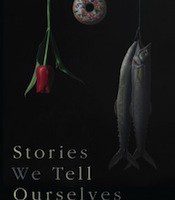Do your dreams stay with you? How about the one about your dead Aunt Ethel, or that one where you’re pushed off a skyscraper by laughing midget rodeo clowns? What do dreams mean, anyway? Michelle Herman’s essay, “Dream Life,” from her new book, Stories We Tell Ourselves, explores the role of dreams in our waking lives. Whether they’re “‘a random firing of synapses’” or if our dreams are pieces of a psychological puzzle that lead toward a picture of self-understanding, Herman uses her own dreams and her own story to allow the reader to make their own decision.
I have mixed feelings about the significance of dreams… I have those surreal David Lynch/William S. Burroughs-kind of dreams where it seems like my subconscious mind is just exercising, and then I have dreams that reflect my own doubts and fears. I was once visited by a decrepit Buddy Rich the night before I had an important gig. In the dream, he sat behind my drums and told me that I was going to suck. I woke up thinking, “What an asshole…” While Herman doesn’t write about the significance of being visited by jazz-drumming greats, she suggests that dreams do have meaning—as long as we listen to them:
Whether a dream’s message is as easy to interpret as turning the knob on an unlocked door [. . .] or so difficult that the unbolting would appear to require the skills of a master locksmith, the opportunity for access it offers to our unconscious minds is unparalleled. Even when access is blocked—even when we cannot unlock the door, when we rattle the doorknob and pick at the lock and pull pin after pin and still the door remains securely closed—when all we can do is marvel at the complexities and strength of the lock itself—I have no doubt that behind that door there are rooms of which our waking selves are unaware, and through which, if only we keep trying [. . .], we have the potential to walk.
Okay, so my Buddy Rich dream was pretty straightforward: a reasonable amount of pre-show nerves with a dash of shaky self-confidence over the thought of playing at a popular venue in front of a big crowd and just bombing.

Chock-full of Herman’s own dreams as this book is, she’s realistic about the fact that dreams are the same as vacation photos when it comes to sharing them with others—almost nobody cares. Even so, the point isn’t in the particulars of each dream. The point lies in using her own dreams as an example of her process for finding each one’s meaning:
What I believe about dreams is this:
That our minds, ‘self-activated’—shut off to the world, turned on to themselves, by the not-very-quiet-after-all state we call sleep—have nothing to process but their own internal workings. In other words, once waking activity stops, once our minds cease to process what we’re doing and what is being done to us [. . .] we are free to tune in, and what rumbles, troubling us, beneath the surface, takes over. And so we dream, simultaneously compressing into a manageable narrative package [. . .] those worries and expanding upon them, making narrative leaps, stringing together images and making metaphors, which themselves run the gamut from the obvious [. . .] through the collective [. . .], all the way up to the most intricate, complex, and wildly mixed [. . .].
Herman’s prose is that of a talkative friend whose passion for their subjects is unerring. She has quite a bit to say. These essays are lengthy—there are only two essays in the book—but Herman’s anecdotes, asides, and use of sources make one-hundred-and-fifty pages pass quickly. These are essays that feel more like conversations, which makes the fact that we’re reading about someone else’s dreams less apparent.
Aside from being a method to better understand ourselves, Herman asks us to consider the possibility that dreams are still something more. Thinking of a dream in which I was chased through a grocery store by an early-1980s Hulk Hogan—wristbands and torn yellow tank top, and all—the skeptical part of me has to ask, “What more could they mean?”
I think sometimes that the real reason we want to tell our dreams is because they are art—the art that everybody makes. [. . .] Dreams provide the universal opportunity to express oneself in metaphor. But the dreamer, as the psychoanalyst and writer Adam Phillips says [. . .], is a most unusual sort of artist—‘at once exemplary and anomalous’—for his only audience is himself.
Stories We Tell Ourselves is a pleasant surprise that mixes personal experience with the science and art of dreams. Herman’s narrative voice takes the reader by the arm and starts sprinting over the vast terrain of her subjects, and it only stops to point out new discoveries. After reading this, I’m waiting for my next falling dream. I have to try to figure out what those laughing midget rodeo clowns are trying to tell me.




